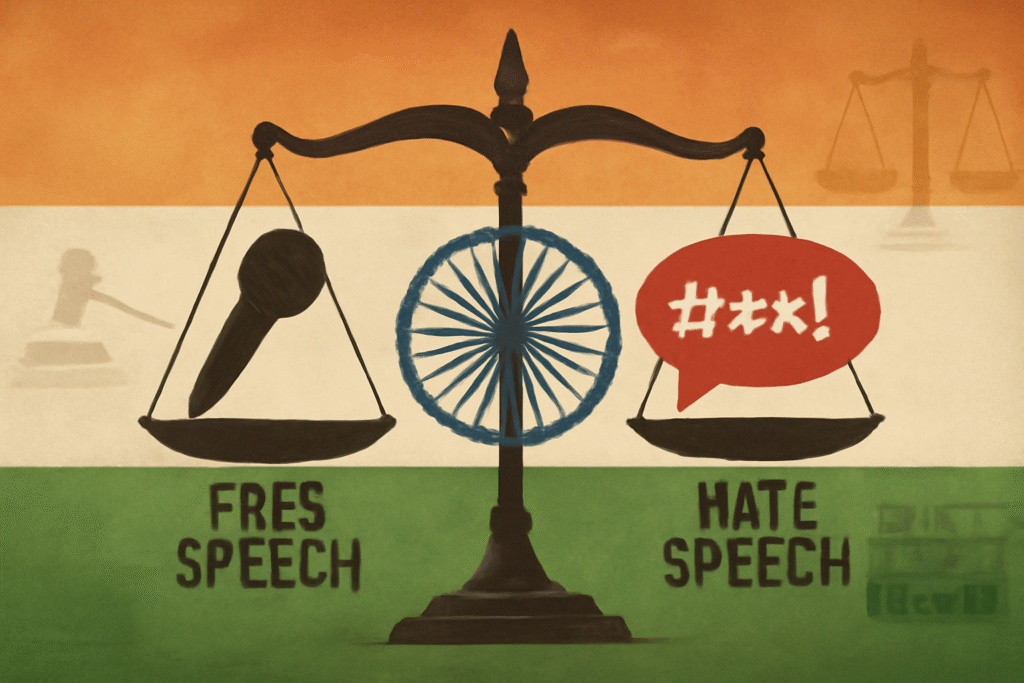Published On: October 28th 2025
Authored By: Anshi Mangal
Babasaheb Bhimrao Ambedkar University, Lucknow
Abstract
The principle of judicial independence, while fundamental to democratic governance, must be balanced with accountability mechanisms, particularly in financial matters. This article examines the framework of budgetary accountability in the Indian judiciary, analyzing constitutional provisions, statutory mechanisms, and judicial pronouncements that govern financial transparency and resource allocation. The paper argues that enhanced budgetary accountability is essential for maintaining public trust while preserving judicial independence, and proposes reforms for greater transparency in judicial expenditure.
Introduction
The judiciary, as the guardian of constitutional values and fundamental rights, occupies a unique position in India’s democratic framework. However, this exalted status does not exempt it from accountability, particularly in matters of financial administration. The concept of budgetary accountability in the judiciary encompasses both the transparent allocation of resources and the responsible utilization of public funds. As Justice V.R. Krishna Iyer observed in State of Bihar v. Kameshwar Singh,[1] “public accountability is the price of public power.”
The tension between judicial independence and accountability has been a subject of considerable debate, with scholars and practitioners grappling with the question of how to ensure financial transparency without compromising the autonomy essential for judicial functioning. This article examines the Indian experience, analyzing the constitutional, statutory, and judicial framework governing budgetary accountability in the judiciary.
Constitutional Framework
Separation of Powers and Financial Independence
The Constitution of India, while not explicitly providing for separation of powers, establishes a framework that ensures judicial independence. Article 50 of the Directive Principles mandates the separation of the judiciary from the executive.[2] This separation extends to financial matters, as recognized by the Supreme Court in the Supreme Court Advocates-on-Record Association v. Union of India (Third Judges Case),[3] where the Court emphasized that financial independence is integral to judicial independence.
Parliamentary Control and Constitutional Limits
Articles 266 and 267 of the Constitution establish the Consolidated Fund and Contingency Fund of India, from which judicial expenditure is met.[4] However, the Constitution provides certain protections for judicial officers. Article 125 ensures that the salary and allowances of Supreme Court judges cannot be varied to their disadvantage during their term of office,[5] while Article 221 provides similar protection for High Court judges.[6]
The Supreme Court in All India Judges’ Association v. Union of India[7] held that adequate facilities and proper infrastructure for the judiciary are essential for the effective discharge of judicial functions, thereby establishing a constitutional obligation on the state to provide sufficient resources.
Statutory Framework
The Supreme Court Rules and High Court Rules
The Supreme Court Rules, 2013, and various High Court Rules provide for administrative and financial procedures. Rule 7 of the Supreme Court Rules deals with the administrative powers of the Chief Justice of India, including financial administration.[8] Similarly, High Courts exercise administrative control over subordinate courts under their jurisdiction, as provided under Articles 235 and 227 of the Constitution.
The Comptroller and Auditor General’s Role
The Comptroller and Auditor General (CAG) of India, under Article 149 of the Constitution and the CAG (Duties, Powers and Conditions of Service) Act, 1971, audits judicial expenditure.[9] Section 16 of the CAG Act specifically empowers the CAG to audit all receipts and expenditure of the Supreme Court and High Courts. This creates a mechanism for external oversight of judicial finances while maintaining appropriate boundaries.
The Judicial Officers Protection Act and Financial Provisions
Various state enactments provide financial protections for judicial officers while establishing accountability mechanisms. The judicial service rules in different states incorporate provisions for financial propriety and accountability, balancing independence with responsibility.
Judicial Pronouncements on Budgetary Accountability
Landmark Decisions
The Supreme Court’s decision in Supreme Court Bar Association v. Union of India[10] addressed the question of budgetary allocation for the judiciary. The Court held that the executive cannot use financial control as a means to undermine judicial independence, but simultaneously recognized that public funds must be utilized with proper accountability.
In State of Punjab v. Davinder Pal Singh Bhullar,[11] the Court emphasized that while judges enjoy immunity from certain forms of accountability, this does not extend to administrative and financial matters where transparency is essential for public confidence.
The National Judicial Appointments Commission Case
The Supreme Court Advocates-on-Record Association v. Union of India (NJAC Case)[12] indirectly addressed budgetary accountability by emphasizing that judicial independence includes financial independence, but noted that this independence must be exercised responsibly with appropriate oversight mechanisms.
Current Framework of Budgetary Accountability
Budget Preparation and Allocation
The judiciary’s budget is prepared through a consultative process involving the Chief Justice of India for the Supreme Court and Chief Justices of High Courts for their respective institutions. The budget is then incorporated into the Union or State budget, as applicable, and placed before Parliament or State Legislatures.
Audit and Oversight Mechanisms
The CAG conducts regular audits of judicial expenditure, with audit reports being tabled in Parliament. The Public Accounts Committee examines these reports, providing a mechanism for legislative oversight. However, the scope of such oversight is limited to financial propriety and does not extend to judicial decisions or case management.
Right to Information and Judicial Transparency
The application of the Right to Information Act, 2005, to the judiciary has been a contentious issue. In Central Public Information Officer, Supreme Court of India v. Subhash Chandra Agarwal,[13] the Supreme Court held that the Right to Information Act applies to the judiciary, including matters of administrative and financial nature, subject to exemptions under Section 8 of the Act.
Challenges in Budgetary Accountability
Inadequate Infrastructure and Resource Allocation
The chronic underfunding of the judiciary has been highlighted in various reports. The Law Commission of India in its 245th Report on “Arrears and Backlog: Creating Additional Judicial (wo)manpower”[^4] noted the severe resource constraints faced by the judiciary and the need for enhanced budgetary allocation.
Lack of Standardized Financial Reporting
The absence of uniform financial reporting standards across different levels of the judiciary creates challenges in ensuring comprehensive accountability. Different High Courts follow different practices, leading to inconsistencies in financial administration.
Limited Public Disclosure
While audit reports are public documents, detailed financial information about judicial expenditure is not readily accessible to the public, limiting the scope of public accountability.
Comparative Analysis: International Best Practices
The UK Model
The UK’s Judicial Office maintains detailed financial accounts and publishes annual reports with comprehensive expenditure details. The Constitutional Reform Act, 2005, established the principle of judicial independence while maintaining accountability through transparent financial reporting.
The Canadian Framework
Canada’s judicial councils publish annual reports detailing expenditure, providing a model for transparent financial administration while preserving judicial independence.
Recommendations for Enhanced Budgetary Accountability
Establishment of Judicial Finance Commission
A dedicated Judicial Finance Commission, similar to the Finance Commission, could be established to assess the financial requirements of the judiciary and recommend appropriate allocations based on objective criteria.
Standardized Financial Reporting
Uniform financial reporting standards should be adopted across all levels of the judiciary, with regular publication of financial statements and expenditure details.
Enhanced Parliamentary Oversight
While respecting judicial independence, Parliament’s oversight role in financial matters could be strengthened through regular scrutiny of judicial budgets and expenditure patterns.
Technology-Enabled Transparency
Digital platforms could be utilized to provide real-time access to judicial expenditure data (excluding sensitive security-related expenses), enhancing public accountability.
Performance-Based Budgeting
The introduction of performance-based budgeting could link resource allocation to measurable outcomes, such as case disposal rates and infrastructure improvements.
Balancing Independence and Accountability
The fundamental challenge lies in creating accountability mechanisms that do not compromise judicial independence. The principle established in Kesavananda Bharati v. State of Kerala[15] regarding the basic structure doctrine suggests that judicial independence is a core constitutional value that cannot be undermined. However, this independence must be exercised responsibly.
The Supreme Court’s observation in Union of India v. Sankalchand Himatlal Sheth[16] that “power without accountability leads to arbitrariness” is equally applicable to the judiciary, albeit within the constraints of maintaining decisional independence.
Future Directions
The evolving nature of democratic governance demands greater transparency in all public institutions, including the judiciary. The challenge lies in developing mechanisms that enhance accountability without compromising the essential independence required for judicial functioning.
The proposed reforms must be implemented gradually, with adequate consultation with the judiciary to ensure that accountability measures do not inadvertently undermine judicial independence. The goal should be to create a framework that enhances public confidence in the judiciary while preserving its constitutional role.
Conclusion
Budgetary accountability in the judiciary represents a complex intersection of constitutional principles, democratic values, and practical governance needs. While the Indian framework provides basic mechanisms for financial oversight, significant improvements are required to meet contemporary standards of transparency and accountability.
The path forward requires careful calibration between independence and accountability, ensuring that financial transparency enhances rather than undermines public confidence in the judiciary. As democratic institutions evolve, so must the mechanisms that govern their accountability, always with the overriding objective of strengthening rather than weakening the foundations of constitutional governance.
The judiciary’s unique position as both a constitutional institution and a user of public resources necessitates a specialized approach to budgetary accountability—one that recognizes its distinct role while ensuring responsible stewardship of public funds. Only through such balanced reforms can India achieve a truly accountable and independent judiciary that serves the constitutional mandate of justice, liberty, and equality.
References
[1]: (State of Bihar v. Kameshwar Singh, AIR 1952 SC 252.)
[2]: Constitution of India, Article 50.
[3]: Supreme Court Advocates-on-Record Association v. Union of India, (1993) 4 SCC 441.
[4]: Constitution of India, Articles 266-267.
[5]: Constitution of India, Article 125.
[6]: Constitution of India, Article 221.
[7]: All India Judges’ Association v. Union of India, (1993) 4 SCC 288.
[8]: The Supreme Court Rules, 2013, Rule 7.
[9]: Constitution of India, Article 149; The Comptroller and Auditor General (Duties, Powers and Conditions of Service) Act, 1971.
[10]: Supreme Court Bar Association v. Union of India, (1998) 4 SCC 409.
[11]: State of Punjab v. Davinder Pal Singh Bhullar, (2011) 14 SCC 770.
[12]: Supreme Court Advocates-on-Record Association v. Union of India, (2015) 5 SCC 1.
[13]: Central Public Information Officer, Supreme Court of India v. Subhash Chandra Agarwal, (2019) 12 SCC 72.
[14]: Law Commission of India, 245th Report on “Arrears and Backlog: Creating Additional Judicial (wo)manpower” (2014).
[15]: Kesavananda Bharati v. State of Kerala, (1973) 4 SCC 225.
[16]: Union of India v. Sankalchand Himatlal Sheth, (1977) 4 SCC 193.




